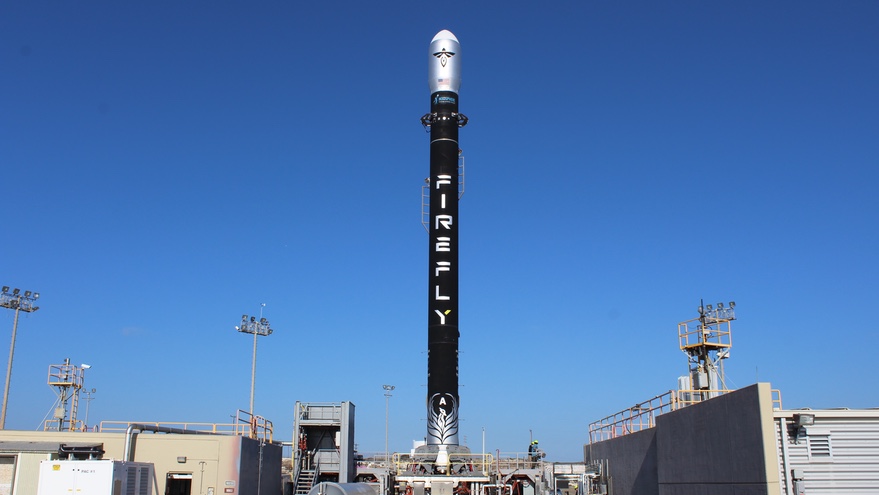WASHINGTON — Firefly Aerospace has hired a former U.S. Air Force officer to lead a rebranded subsidiary responsible for sales of its launch vehicles and other capabilities to government and commercial customers.
Firefly announced Nov. 3 that it hired Jason Mello to be president of Firefly Space Transportation Services (STS), a subsidiary responsible for sales of its Alpha rocket, Blue Ghost lunar lander and in-space transportation services. Mello, a retired Air Force colonel with 23 years of service, was previously chief research and technology officer for science and engineering at the Air Force Office of Scientific Research, and held other defense and intelligence positions, many related to launch and space systems.
Firefly STS is the new name of Firefly Black, the subsidiary originally responsible for federal government sales. Under the new name, the subsidiary will be the primary business development organization for both commercial and government customers.
“I wanted to go back and be part of NewSpace,” Mello said in an interview. “Firefly really excited me on what they were doing. It really was the three different business lines. It’s much more than just a launch company.”
As head of Firefly STS, he said he will “look across and really develop and build this subsidiary into the outward-facing arm of Firefly Aerospace,” working with government and commercial customers. “It really was a great opportunity that I couldn’t pass up.”

“Jason is the right person for this position because he’s really seen the whole evolution of our business, and in particular the small space transportation business,” said Tom Markusic, chief executive of Firefly Aerospace, in a separate interview. “He was one of the people who saw early on the need and benefit for dedicated small and medium space transportation solutions.”
Mello said he saw a “multitude of different opportunities” for Firefly among different government customers. “Having spent 23 years on the government side, I know there’s a lot of requirements that need to be done and I know Firefly is poised to do that,” he said. That includes launch and in-space transportation services for national security space customers and, for NASA in particular, expanded roles for its lunar lander.
“On the commercial side, it’s really to translate what we’re doing on the government side with the three business lines,” he said. “Overall, it made sense for us, after talking with Tom, to provide that in this one subsidiary, Firefly STS.”
Combining commercial and government sales into a single organization made sense, Markusic said, since it involves similar work. “It’s more efficient to have the same types of people writing proposals, the same types of people doing sales work, and just aggregating it into one group.”
Mello said it’s too soon to predict the balance of commercial versus government business that Firefly STS will handle. “I wish that had that crystal ball to understand where that future is,” he said, adding he expected to have a better handle on that balance in the next few months. “Our goal right now is to go out and look at every opportunity out there on the commercial and the federal government side, to be at the table and be able to provide our services.”
The portfolio of Firefly STS won’t extend to sales of engines and other vehicle components, an initiative Firefly announced in August. Markusic said those sales will be done by Firefly Aerospace, since it involves dealing with a different set of customers — other launch vehicle developers — than those Firefly STS will work with.
Markusic said that, so far, Firefly hasn’t done much in the way of components sales. “We haven’t emphasized it. We’ve been super busy,” he said. “I do hope next year, once we’ve established that regular launch cadence with Alpha, that we can spend more time cultivating that part of the business.”
Alpha, Beta and Blue Ghost
Firefly launched its first Alpha rocket Sept. 2 from Vandenberg Space Force Base in California. However, one of the four engines shut down 15 seconds into flight, dooming the mission. The rocket continued to ascend until it tumbled out of control when it reached maximum dynamic pressure, triggering range safety systems to detonate the rocket.
Markusic said that an investigation led by Lauren Lyons, chief operating officer of Firefly, found that the engine shut down when an electrical connection failed, causing propellant valves to close and shutting down the engine. “It’s a fairly easy and straightforward thing to fix,” he said. “We’re not doing anything to the vehicle expect changing that electrical connector and some minor things to make the system work better.”
He said the first stage of the second Alpha rocket will go on a test stand late this week, followed by the second stage. The vehicle should be at Vandenberg in December for a launch planned for late January.
If that next launch is successful, Markusic said Firefly plans four more Alpha launches in 2022. That includes a launch for NASA’s Venture Class Launch Services program, slated to be the fourth Alpha launch.
The company is working in parallel on its Space Utility Vehicle space tug. Firefly planned to test a thruster for that tug on the first Alpha launch, and Markusic said an “identical technology demo” for it will fly on the next Alpha mission. The first fully functional version of the SUV is scheduled to fly in about 15 months, he projected.
Firefly recently completed the critical design review for the Blue Ghost lunar lander that will fly in 2023 on a mission for NASA’s Commercial Lunar Payload Services program. “We’ve been getting great reviews from our NASA customer,” he said. “Everything’s on schedule for the hardware.”
Firefly is also looking ahead to Beta, a medium-class launcher capable of placing up to 10 tons into orbit, an order of magnitude more than Alpha. In the interview, Markusic suggested Firefly is considering partnering with other companies in the development of Beta rather than developing it entirely in-house, as it did with Alpha.
“Hopefully, in the next few months we’ll be able to announce potentially a strategic partnership in the development of Beta,” he said. “In the spirit of what’s going on with consolidation and people teaming up, there’s a good chance that Beta will be a multi-institutional development effort.”
